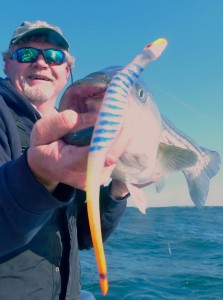 Along with sneaking in a couple of catch-and-release fishing trips, I’ve been reading all I can lately about why we catch fish with ease on some days, and why we cant buy a bite at other times. I can’t say I’ve solved that mystery, but I’ve included most of the knowledge I’ve gained in a PowerPoint slide show that I will present over the next couple of months to area fishing clubs. If you attended the Annapolis Saltwater Fishing Expo last weekend, you’ve already seen this show, but don’t be surprised if it morphs into a somewhat different format as I present it to different groups and organizations. I learn more every time I talk to fellow fishermen, pick up a book, read a magazine article, look at a website, and (especially) when I go fishing. Here’s a sneak preview of my Strike Triggers presentation:
Along with sneaking in a couple of catch-and-release fishing trips, I’ve been reading all I can lately about why we catch fish with ease on some days, and why we cant buy a bite at other times. I can’t say I’ve solved that mystery, but I’ve included most of the knowledge I’ve gained in a PowerPoint slide show that I will present over the next couple of months to area fishing clubs. If you attended the Annapolis Saltwater Fishing Expo last weekend, you’ve already seen this show, but don’t be surprised if it morphs into a somewhat different format as I present it to different groups and organizations. I learn more every time I talk to fellow fishermen, pick up a book, read a magazine article, look at a website, and (especially) when I go fishing. Here’s a sneak preview of my Strike Triggers presentation:
Have you noticed that some fishermen seem to steadily catch big fish and regularly have successful days even when others don’t? What are they doing differently? In my opinion, one trait of consistently productive fishermen is an appreciation for the concept of strike triggers. They may not always call it that, but you can pretty well bet that good fishermen are incorporating techniques in their lures and lure presentations that trick fish into biting even when they’re not particularly inclined to eat. It starts with a good understanding of the five reasons why striped bass attack a lure.
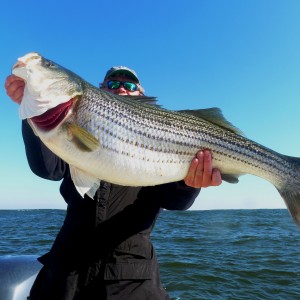 Five Reasons Why Stripers Attack
Five Reasons Why Stripers Attack
1. Hunger Strikes – When stripers are hunger feeding, they’re usually pretty easy to catch. A good example of a hunger bite is when fish are attacking large bait pods under diving birds. Locating a school of hunger feeding fish almost always means good fishing, and almost any bait or lure will work. Unfortunately, it doesn’t always happen that way. Maybe there isn’t enough bait around, or for some reason the fish are just not inclined to eat. Since most of us have to fish in the limited time we can find, and close to home where conditions can be challenging, it isn’t always possible to go off looking for actively feeding fish. Instead, we have to convince the fish that might be nearby to take our lures. That’s when it pays to look at other reasons why they bite besides hunger.
2. Reaction Strikes – These strikes happen when the fish just can’t help it because a lure or bait triggers an instinctive reaction. It’s often the result of a particularly attractive lure that is presented in such a way that it’s just irresistible. In Chapter 1 (page 21) of my book, Chesapeake Light Tackle – An Introduction to Light Tackle Fishing on the Chesapeake Bay, I tell the story of a big fish and a reaction strike.
3. Competition Strikes – Have you ever caught a rockfish and noticed other fish trying to take the lure away from it? Stripers often behave like dogs, cats, and even humans when they try to take away whatever a competitor is attracted to. When one fish gets caught, other fish come running to see what the commotion is all about. You can sometimes keep a school of fish excited and biting and right under your boat just because they are competing with each other for your bait.
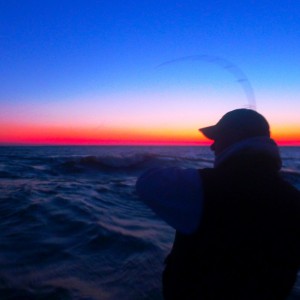 4. Territorial Strikes – While most stripers feed in schools of similar size, bigger fish often stake out hiding places from which to ambush bait. These solitary trophies will often protect their feeding territory from competing stripers and from other species. Big stripers that hide along the shoreline and around underwater cover are especially territorial and will sometimes take a lure just because it’s in their feeding zone.
4. Territorial Strikes – While most stripers feed in schools of similar size, bigger fish often stake out hiding places from which to ambush bait. These solitary trophies will often protect their feeding territory from competing stripers and from other species. Big stripers that hide along the shoreline and around underwater cover are especially territorial and will sometimes take a lure just because it’s in their feeding zone.
5. Curiosity Strikes – There are times when striped bass will take a lure simply because they’re curious about what sort of creature might have wandered into their lair. Curiosity strikes don’t happen often, but it’s important to be aware of them and plan accordingly.
In my talk, I go over each of the above reasons why rockfish bite and talk about how we can select and modify lures and lure presentations so they produce strikes even when fish aren’t particularly hungry. I also take a close look at the five senses stripers employ to locate and identify their prey using the concept of comparative anatomy. The science of comparative anatomy takes what we know about animal species that have been adequately researched, and applies that knowledge to the traits 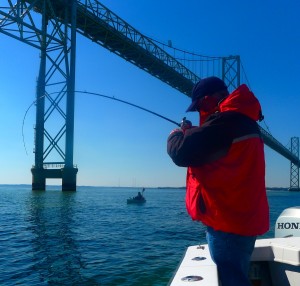 and behaviors of fish like striped bass. If that all sounds way too complicated, don’t worry. The results are interesting, but they confirm a lot of what fishermen have known for generations. In most cases, it provides scientific reasons why the lures we regularly use are frequently successful.
and behaviors of fish like striped bass. If that all sounds way too complicated, don’t worry. The results are interesting, but they confirm a lot of what fishermen have known for generations. In most cases, it provides scientific reasons why the lures we regularly use are frequently successful.
My Strike Triggers presentation is 45 – 60 minutes long and includes photos and videos, so I’ll save the rest for the talks. Scroll down a couple of entries on the main Chesapeake Light Tackle page for a schedule of when and where I’ll be speaking. There’s also more information about strike triggers in my book.
As previously mentioned, I fished both the Bay Bridge area and at some of our region’s warm water discharges this past weekend and found fish everywhere I went. I can’t really say they were easy to catch though. The hunger feeding bite only lasted a few short minutes during each tide cycle, and the rest of the time fishing was tough. Even so, there are some very nice fish around as migratory fish are now entering the Bay in advance of the 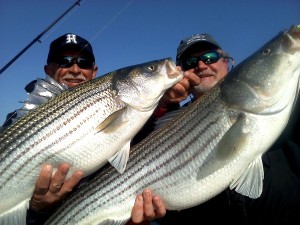 spring spawn. My best lures have been hotrodded BKDs and jig heads that we’ve modified to incorporate proven strike triggers. Most fish are easily released in the water since we’re using barbless hooks, but we held up a few for photos. Water temperatures are holding in the mid-40s, so it’s even possible to find fish feeding beneath birds in the open Bay right now. Gannets have been reported as of today and we are encountering migratory fish with sea lice.
spring spawn. My best lures have been hotrodded BKDs and jig heads that we’ve modified to incorporate proven strike triggers. Most fish are easily released in the water since we’re using barbless hooks, but we held up a few for photos. Water temperatures are holding in the mid-40s, so it’s even possible to find fish feeding beneath birds in the open Bay right now. Gannets have been reported as of today and we are encountering migratory fish with sea lice.
The yellow perch spawn is on in the upper reaches of tributary creeks and rivers. Reports of white perch catches are just starting to roll in. They should be spawning over the next couple of weeks. Crappie are still in a deep-water pre-spawn pattern, but consistent catches are reported throughout the Maryland portion of the Bay. Pickerel fishing has been steady.
Good luck fishing this week. I hope you can get out and take advantage of the great weather we’ve had lately. I hope to see you at one of my upcoming talks, or better yet, out there on the water!




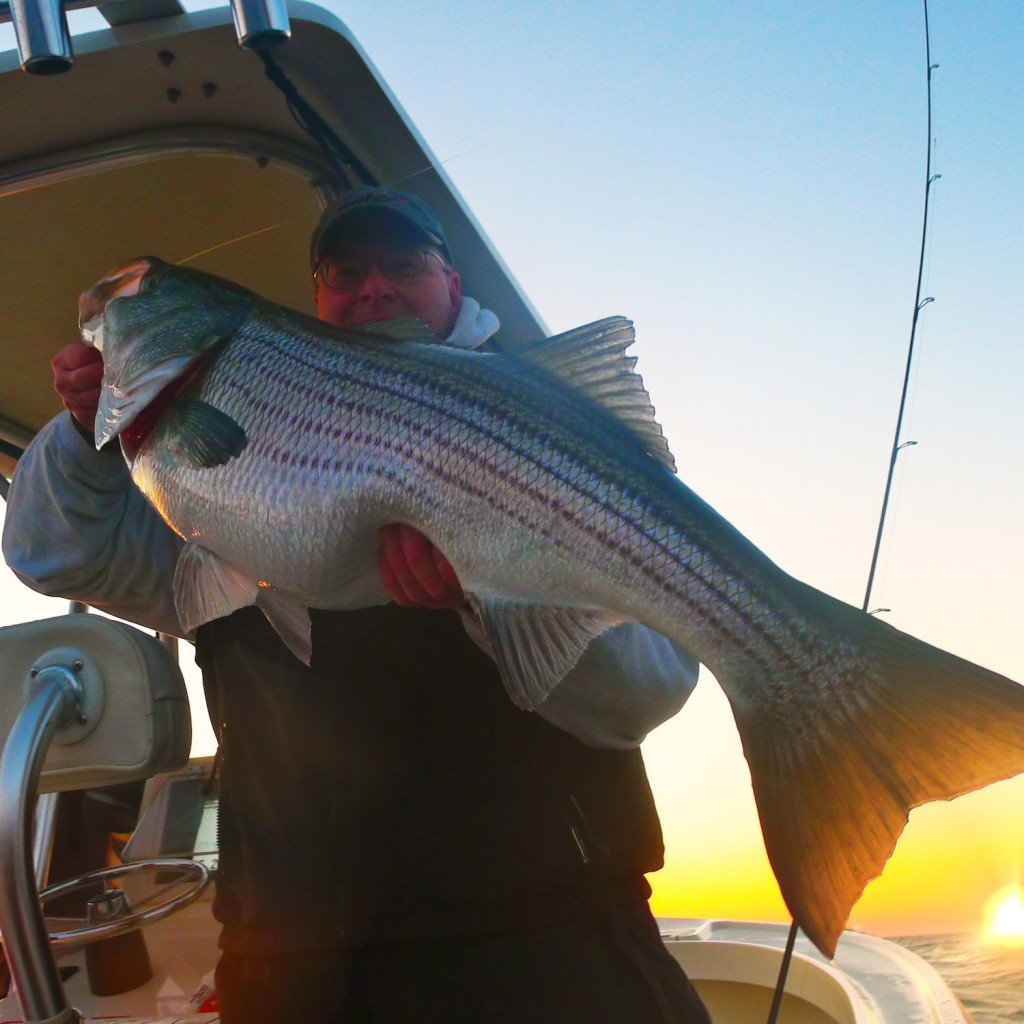
Another great read! Thanks for the info… Very interesting as to what really makes fish strike.
Thanks, Joe. Hopefully we can get out together soon. I’m jealous that Rich got a trip in with you last week.
We had fun and caught well that day… I concocted a “Drunken Alien” lure… Jamie said it was second only to “the Lizard”… it caught my better fish that day…
Been a student of “comparative anatomy” for years…gets me in trouble with the wife, though.
Ha ha… Just don’t compare too closely.
Great read, Shawn.
You have a real gift to be able to breakdown the actions of the fish and the ways of the Bay…thanks for sharing.
It has me wanting to hear more of your presentation at our upcoming MSSA meeting on 3/13 😉
Thanks for stopping by, Mark and I’m looking forward to that meeting on 3/13 in Catonsville.
Shawn,
Thanks for the insightful article. Congratulations on those hawgs! They must be the ones that you told me about earlier. I’d like to get a crack at the yellows, and I have a couple headwaters in mind. Anyway, keep up the good work.
Don
Thanks, Don. And congrats on the new HDS system you are getting. Those fish under gannets should get a lot thicker in a few weeks.
Those are beautiful fish (and great pictures) and an interesting report. I will try to catch your presentation at the DC Metro MSSA meeting on March 7. That is one wild looking lure in your first picture. What is it?
Bill, it’s a 10-inch Bass Kandy Delight (BKD). I think one of my boys hotrodded this one over the holidays by dipping the tail in colored, scented dye a couple of times, then highlighting the ribs with a colored marker. It isn’t pretty, but it’s a fish catcher. Hope you can make it to the DC meeting next week.
Oh brother, you sure know how to hrut a guy whose boat is winterized. That last picture should be on a magzine cover.
Is dewinterize a word? It should be!
That tiger striped 10″ BKD sure caught my eye.I think its purty !
Do you use the round jig heads much?It seems I get less snags in the rocks.
Thanks for the Excellent info and pics ,some really beautiful fish caught,way to get em Fellas!
Very informative, especially for an anxious rookie. As a photographer, great photos, memories of the ones that didn’t get away!
Hope you get in a lot of fishing this year, Cindy. I have a feeling you have some big ones in your future, despite those guys you hang out with up there ;-)!
Huh?
Is that Jamie Clough with the big one in that last picture?
Of course it is…
Must’ve been suspended…
Jamie who? Never heard of him. And yes, the dumb ones were suspended. Personally, I just fish for smart fish.
It’s the ethical thing to do, also more challenging, and more rewarding in the long run. Just sayin
Shawn, that was the big guy hogging the front of the boat the other day.
I’m glad he let me cast one time up there. Very nice of him.
I would rather fish for the “dumb” ones…they look just the same and the pics comes out a little better…
BTW Daniel I got stopped and boarded by DNR last week…Rich could not wait to show him his VLM numbers he had stored in his phone…I didn’t have the heart to tell him that you only need then in Va…HeHe
Man, you got some Karma comin!
The bad kind
I’ve heard catching fish during the times of new and full moons is most productive. You do mention tide cycle. Have you correlated striper bites with the moons?
A good moon (new or full) means more tidal movement, thus more current. I don’t buy the theory that striper fishing is harder during a full moon. It’s always been better for me because the current triggers a better bite. Same for new moons. Good question.
Shawn,
Were you all fishing the BKD’s slowly similarly to how one would fish for largemouth bass in the winter? Thanks.
Don
No two days are alike, but it doesn’t seem like we’ve had to put too much action in our lures over the last couple of weeks. The hard part has been getting them in front of a fish. Typically, I jig about the same year round. If the bite is good, no reason to move the lure too much, but when the bite falls off, I start “cracking the whip” even in the dead of winter.
Hey Guys,
I just enabled email notification when someone adds to the comments. Just check the box below the comment box and you will get emailed whenever someone replies to the article. Let me know if it works for you. I’m hoping this makes it easier for you to follow the conversations going on.
I wondered what you were up to. Thanks, James!
Great idea. Is CLT.com the fastest growing social-fishing site? Every post garners more attention, and more and more comments are posted. -DK
I think you forgot one….Picky eaters,thats right being just plain finicky.I learned this 2 years ago while live lining spot at the gas docks.We had almost caught our limit,we still had tide carrying the smell.Our baits were fresh and lively.But the fish were just not biting,we tried jigging and topwater but the fish were clamped shut.There was a school under our boat thick enough to walk on so that wasn’t the problem.Out of curiosity I decided to try somthing.I had bought some soft crabs at the shed house next to our bait shop,they were to take home to momma so if she sees this I may be in trouble!I swapped my spot for a half of a fresh soft crab and my bait barely hit the water before a 29″ rock inhaled it!the res of the boys quickly changed baits and we had our limit in 3 minutes.There were 25 boats around us and we were the ONLY ones catching fish!That includes 5 fishing charters that were watching me intensely ( and grumbling I might add).So even if you are fishing live bait thats fresh consider a change in taste buds!